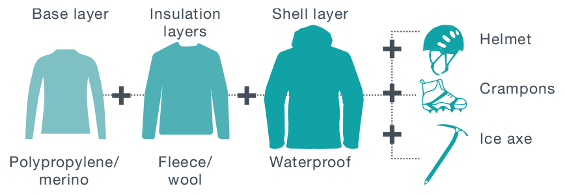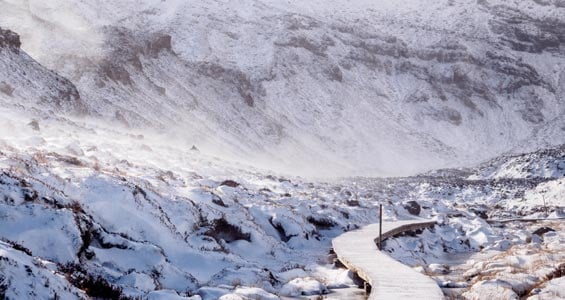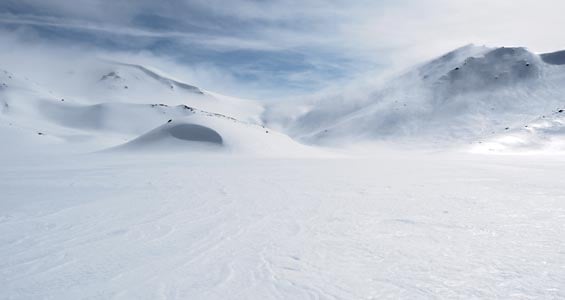May to October – winter season
Track standard: Route
Track surface: Track is covered in snow and very icy in sections.
Suitable for: People with alpine skills, equipment and experience. You must:
- know how to navigate if cloud or snow covers the marker poles and you cannot see them
- know where avalanches are a risk and be able to rescue someone if an avalanche occurs
- have the equipment and skills to prevent a slide on icy terrain
- have the clothing for sub-zero temperatures and be able to survive if the weather gets worse.
Prepare for a long, challenging day

Allow 9 hours to complete the walk. There are between 9 and 11 hours of daylight in winter, so leave early enough to complete the trip before it gets dark. Always take a head torch.
Be prepared to turn back if conditions are no longer safe or if your progress is too slow.
Dress for cold, windy and icy conditions
On a calm day, Red Crater is at least 10°C colder than Taupō and 5°C colder than the start of the track – subtract another 2°C for every 10 km/h of wind:
Eg, when it’s 10°C (50°F) in Taupō, a calm day at Red Crater will be about 2°C (35°F). This feels more like -2°C (28°F) with moderate winds of 20 km/h (11 knots).

Conditions can change quickly. Layer your clothes to trap warm air in and keep cold wind out. Start with a base layer of polypropylene/merino, add an insulation layer of fleece/wool and finish with a waterproof shell layer.
Expect ice on the track between April and October. A helmet, crampons and ice axe are essential, as is competency using them. 38% of tramping injuries are from slipping.
Be avalanche alert
Avalanches are a hazard. Know the avalanche forecast. Take an avalanche transceiver, avalanche probe and snow shovel, and be competent using them.

Take these essentials
- Plenty of drinking water (water along the track is not suitable for drinking), food and toilet paper
- Waterproof jacket and pants, hat, gloves, sunscreen, and warm, layered clothing
- Sturdy tramping or mountaineering boots
- Crampons, ice axe and helmet
- Avalanche transceiver, avalanche probe and snow shovel
- Mobile phone, personal locator beacon (PLB), head torch and spare batteries
- Map, compass and/or GPS
Make a plan
Talk with someone at the Tongariro National Park Visitor Centre who knows the current conditions.
Check the latest:
- avalanche forecast – New Zealand Avalanche Advisory website
- volcanic alert level – GeoNet website
- weather forecast – NIWA website
Know the route – deep snow can hide track markers.
Shuttle buses generally don't operate during winter, but guided trips include transport.
Go with a guide
Know your limits. Have a memorable and safe experience with Tongariro Alpine Crossing guiding companies.

Mangatepopo Valley in winter
Image: Zhi Yuen Yap ©

South Crater in winter
Image: Zhi Yuen Yap ©